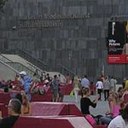0025 Muzeum otwarte na ulicę
Identifiers (Article)
Identifiers (Files)
Abstract
Przeszklone sale wystawowe, które dają przechodniom możliwość zapoznania się z dziełami sztuki z poziomu i perspektywy ulicy, bez wchodzenia do środka. Widoczny z zewnątrz, kuszący przechodniów, asortyment artystycznej księgarni. Stoliki kawiarniane wychodzące w przestrzeń przyległego placu. Rzeźby, instalacje, a także ławki i fontanny umieszczone w przestrzeni publicznej, stanowiące przestrzeń wejścia. To elementy charakteryzujące demokratyczne instytucje sztuki. Muzea, galerie i centra sztuki, zwłaszcza współczesnej, wychodzą w przestrzeń ulicy, by zachęcić przechodnia do wejścia. To Przenikanie się dwóch światów – zewnętrznego ulicy i wnętrza kryjącego skarby kultury oraz wzajemne obserwowanie – stało się częścią procesu poznania w muzeum i artystycznych doznań.
Statistics


License

This work is licensed under a Creative Commons Attribution-NonCommercial-NoDerivatives 4.0 International License.



